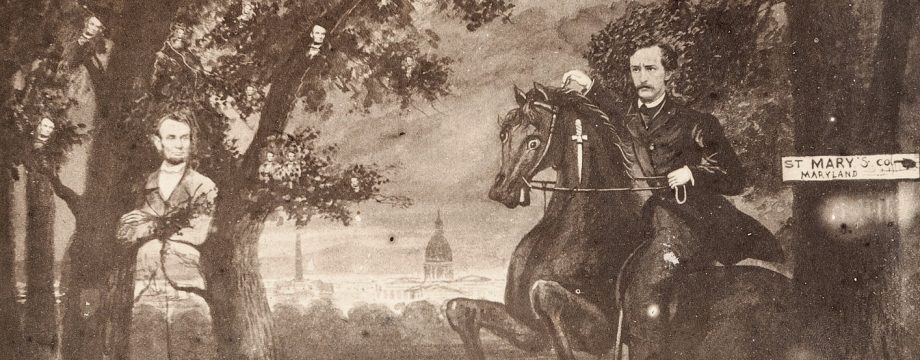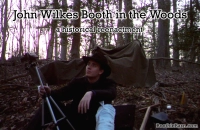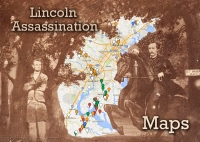When Booth was committing his deed at Ford’s Theatre on 10th Street, Lewis Powell was simultaneously entering a residence in Lafayette Square with malevolent intent. His mark was Secretary of State William H. Seward, an integral member of Lincoln’s cabinet and political team. Powell’s house-wide knife attack would wound five but none fatally.
The house the Secretary of State occupied was a stone’s throw from the White House. Commissioned by Commodore John Rodgers, the building would serve as the home of many important politicians like James Blaine, James Paulding, Roger Taney, and William Worth Belknap. When the White House was being renovated in 1845, President Polk used the house for his temporary residence.
In 1894, the Rodgers House was sadly demolished. The Lafayette Square Opera House was built on the house’s site.
In 1906, the theater was bought by new owners and became The Belasco Theater. The theater saw the likes of Al Jolson and Will Rodgers perform within its walls. As times changed, the Belasco converted into a movie theater, but its career as such was short lived. In 1940, the federal government bought the Belasco and nearby buildings. The inside of the theater was remodeled and used as office and storage space, not unlike Ford’s Theatre had been. During WWII, the building was reopened as a social club for Armed Forces members called The Stage Door Canteen. Aside from a temporary revival as a military club during the Korean War, the building was used as offices for the USO.
Finally, in the 1964, the end came for the old Belasco building. The old theater was razed in order to create the Federal Court of Claims building. The Court of Claims still resides on the property.
While the house that was a silent witness to the assault of Secretary of State Seward is long gone from Lafayette Park, the history of the site is not forgotten. While slightly hidden within the courtyard of the Federal Court of Claims building, there is a plaque to remember not only Lewis Powell’s presence on the site, but the other individuals and businesses that were once the President’s neighbors.
References:
Library of Congress











Interesting piece Dave. I find it kind of ironic that a theatre was erected here after the old house was demolished. I always enjoy reading these posts over a cup of morning coffee.
Very interesting, Dave. It’s too bad that no extant floor plans/blue prints seem to exist for the Old Clubhouse (Seward’s house.) Linda Anderson and I are STILL looking for these!
Surprisingly, the plaque makes mention that Powell was “one of the conspirators who murdered Abraham Lincoln.” Supposedly when given the chance by Booth to assassinate Lincoln in February of 1865, Powell refused and walked away. The plaque also makes no mention of the facinating history of the house BEFORE the assassination – i.e. the Key-Sickles murder which occurred outside of it’s front door in 1859. Philip Barton Key was brought into the Old Club House as it was then called due to its designation as a Gentleman’s Club, where he expired after being shot by Daniel Sickles.
I believe Sickles told him, “Key, you have dishonored my bed. For that you must die.” Very interesting history!
I always assumed that the photo you show of the house was the way it appeared in the 1860’s. I nevr bothered to compare it to the 8165 woodcut. This is the first time I’ve seen them side by side, so to speak. Apparently, the photo was taken in later years, as the architecture over the front door was altered from its appearance in the woodcut, and a chimney was also added. I guess the reason that the Key-Sickles affair wasn’t mentioned in the plaque lies in the fact that the structural virtues of the opera house — which took so much space on it — were extolled by the family of the theatre’s builder. I wish we could see a close-up of the picture of the “Old Club” that appears in a circle on the top of the plaque, in bas-relief. That looks neat.
Obviously I meant 1865, not 8165. That’s a good one!
Really interesting. I wish the house could have been preserved. Speaking of safe houses, Dave, Laurie Verge, Betty O, and other history buff friends in the East, take care and stay safe!
I have a little info on the booth birthplace that you might find interesting (its part of a PDF document). I couldn’t find an address on the blog to email the document to. Send me one and I’ll forward the document to you. (I assume you can get my email address from the registration)
Elsie,
You can e-mail me at boothiebarn (at) gmail (dot) com. I look forward to seeing what you have.
Thanks,
Dave
Julie, thanks for your kind thoughts. It’s a little after 1:30 pm on Monday, and the rain and wind are really starting to pick up. Still not a hurricane, but I guess the worst is yet to come.
Dave, I notice that the caption under the boat sketch says that Booth paid $300 for it. Not quite right. Even the one that they had “reserved” for the original kidnapping didn’t cost that much.
Back in the early-1970s or late-60s, several of the “old timers” in our field attempted to row across the Potomac in the “flight pattern” of Booth. An afternoon storm came up, and they had a difficult time getting back to shore. At one point, they were bailing the boat due to the waves.
I have photographs of that, Laurie! Mr. Hall, John Brennan and Richard Sloan participated in this – I think it was back about 1978-1979…..
Pingback: “Like the Scenes of Some Hideous Dream”: Lewis Powell’s Assassination Attempt on Secretary of War Seward | Emerging Civil War
george f. robinson, the wounded soldier attending seward on 4/14/1865 , had powell/paines knife afterwards. it is currenrly in the huntington library,san marino,ca. he was awarded a congressional gold medal some years later. currently incustodyof themuseumof Anerican history on the mall. Robinson is interred at Arlington cemetery.